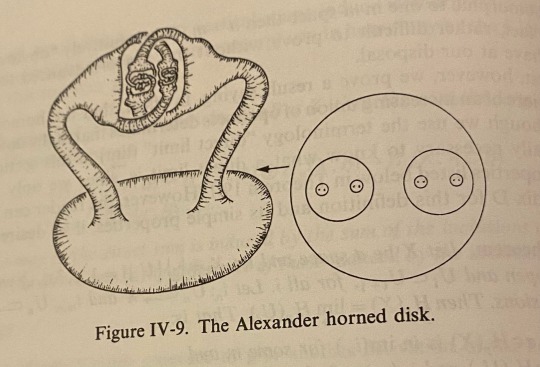23⚫He/Him⚫Maths PhD Student ⚫Noncommutative Algebraist⚫Asks Welcome I make youtube videos on math
Don't wanna be here? Send us removal request.
Text
Meeting Charles Weibel tomorrow, should I tell him about all the mistakes I found in his book?
12 notes
·
View notes
Text
Hey remember when I made videos? Anyways the new episode is out: https://youtu.be/Qw7uX1NmcjM And of course the associated blog post:
I started a blog series (Which will be accompanied by a video series soon) on schemes. The first chapter is on classical algebraic geometry, and the first notions of a generalisation to arbitrary rings. Unfortunately, since tumblr doesn't have LaTeX integration yet, I decided to do this off-site on Functor Network, so that means you will have to go through the mental anguish of clicking a link:
I hope it's worth it.
Edit: Associated video going live tomorrow on youtube:
youtube
98 notes
·
View notes
Text
Throwback to the time I made a twitter account called "Kevin Blizzard" specifically to post gifs like this under Kevin Buzzard's tweets:

And then he followed me

22 notes
·
View notes
Text
Cute Group Theory Problem
I've been TAing for this math summer program at Penn, and we were doing some group theory on a Rubik's Cube. I gave them the problem of finding the center of the Rubik's Cube group, which is a really cute problem! (I actually got this problem from emily riehl by proxy, and by which I mean I learned it from someone who heard it from emily riehl).
So yea, try and determine Z(G) for G the Rubik's Cube Group.
RB for hints.
38 notes
·
View notes
Text
Oops! The one thing I forgot to check.
goal: find a ring (with identity) structure on the set of all finite dimensional matrices over a ring R.
rules:
must somehow be matrix-y
you cannot add things to the set (ie no infinite matrices, no formal linear combinations)
equivalence classes are okay so long as it still satisfies the main goals.
you can choose R as long as it's not a boring choice, but ideally it is generalizable
help
72 notes
·
View notes
Text
Take the direct limit of matrix rings, where the embedding is by embedding in the top left block and adding 1s on the diagonal. This guarantees the identity always maps to the identity, so this is a direct system of rings.
Concretely, the direct limit is a quotient set on the set of all matrices, and no infinite 1s (It's kind of circumventing that).
goal: find a ring (with identity) structure on the set of all finite dimensional matrices over a ring R.
rules:
must somehow be matrix-y
you cannot add things to the set (ie no infinite matrices, no formal linear combinations)
equivalence classes are okay so long as it still satisfies the main goals.
you can choose R as long as it's not a boring choice, but ideally it is generalizable
help
72 notes
·
View notes
Text
My Difftop professor last semester would go on these incredibly long, sometimes full-lecture tangents about a hypothetical mock trial between vector fields and differential forms.
I wasn't actually there to witness it but I hear it was a thing of beauty.
I want weird math textbooks. Group theory textbooks in the style of a comic book. Real analysis textbooks written as a long dialogue between forest animals. Elaborate romantic fan fictions about the relationships between Lie groups and their corresponding Lie algebras.
5K notes
·
View notes
Text
A group walks into a Bar. There is no Resolution.
24 notes
·
View notes
Text
That feeling when you have a space but that space is actually a functor but it's actually a space.
7 notes
·
View notes
Text

There he is. There’s my boy!!!
237 notes
·
View notes
Text
I started a blog series (Which will be accompanied by a video series soon) on schemes. The first chapter is on classical algebraic geometry, and the first notions of a generalisation to arbitrary rings. Unfortunately, since tumblr doesn't have LaTeX integration yet, I decided to do this off-site on Functor Network, so that means you will have to go through the mental anguish of clicking a link:
I hope it's worth it.
Edit: Associated video going live tomorrow on youtube:
youtube
98 notes
·
View notes
Text
Just finished the second episode in my noncommutative algebra series!
Please check it out!
youtube
12 notes
·
View notes
Text
Use of Hilbert's Hotel in Set Theory
I'm helping out some freshmen in their mathematics fundamentals course, and this wonderful argument came up:
Suppose that I have an infinite set, where the definition of infinite we are using is that contains a countable (i.e. bijective to the naturals) subset. This definition assumes the axiom of choice (don't worry about it), but if you'd like, replace the general set in the rest of this post by the real numbers, which we know contain the natural numbers as a countable subset. Let X be an infinite set, and {x_0,x_1,x_2,....} be a countable subset. Suppose we want to add a point to x. The context that this came up in was constructing a bijection from the half- closed ray [-2,inf) to the real numbers. You might know that if this were an open interval (-2,inf) then a bijection would easily be given by R->(-2,inf), x|-> (e^x)-2. Its inverse is log(x+2). We want to "hide" the point, get rid of it somehow. In other words, we add a point * to our set which is disjoint from it, and we want to construct a bijection X u {*} -> X, thereby hiding the point. In the case of the problem, this is a bijection [-2,inf)->(-2,inf), and our point * would be -2. You might know of Hilbert's Hotel, which has infinitely many rooms numbered 1,2,3,.... and is fully occupied. A new guest requests a room, so to accomodate them, the guest at room 1 moves to room 2, the guest at room 2 to room 3, and so on, so all the guests still have a room, but now we have room 1 for our new guest! We employ the same idea here, defining a function by:
f(x) = x_0 if x=*
x_{n+1} if x=x_n,
x otherwise
Then f is a bijection X u {*} -> X (Check!). We "made room" for our new point * by moving our countable set up an index, just as in Hilbert's Hotel!
In the case of our bijection [-2,inf)->(2,inf), we use the natural numbers, so we map -2 to 0, 0 to 1, 1 to 2 etc, and all other points to themselves.
Now we can compose our bijection with the bijection (-2,inf)->R we described earlier to show that [-2,inf) is in bijection with R.
Even basic set theory is cool
20 notes
·
View notes
Text
Fun fact I actually went to a lecture about MOND from the inventor himself in highschool at Weizmann Institute and even back then we all thought he was kind of a crank. Speaking with grad students they said it's all he talks about, and he adamantly rejects any criticisms.
Dark matter skeptics like to make claims about parsimony–if we're only trying to explain discrepancies in gravitational observations, why posit the existence of entire new, magical particles when we could just tweak gravity directly instead?–but this argument makes absolutely no sense to me. Our modern understanding of physics puts relatively few constraints on the number and kinds of particles that might exist in the universe. General relativity, on the other hand, has a much more rigid theoretical structure and far fewer free parameters. Even leaving aside the shaky experimental status of MOND (and yes, it is shaky, especially in the last few years), a new particle is a much less drastic and more parsimonious addition to our theories than an ad-hoc correction to the fundamental laws of gravity. Reconciling that with current fundamental theory is a massive task.
As far as I can tell, the actual primary source of skepticism is just "if they were real, we should've seen them by now". But why would that be true? There's no law of the universe that says particles have to be easy for humans to detect. That belief comes from either an attachment to human senses as the arbiters of reality displaced onto only the forms of scientific observation that feel most tangible, or an unjustified blind faith in the ultimate adequacy of current experimental methods.
#notmath#physics???#the last criticism is so silly#like bruh it took us so fucking long to understand to find the particle responsible for MASS#in the same lecture series we also had a lecture on dark matter
58 notes
·
View notes
Text
Can't believe the father of stochastic analysis is named fucking Norbert Wiener that wouldn't be out of place in a diary of a wimpy kid.
And he looks like this

I love him
11 notes
·
View notes
Text
It's 5am and I keep having to draw pairs of pants because I have to give a talk tmrw.
Real ones will understand
8 notes
·
View notes









